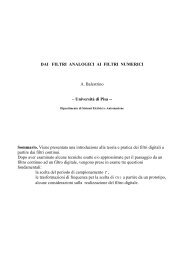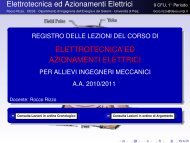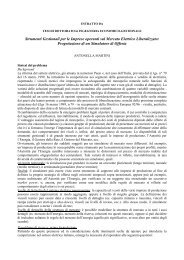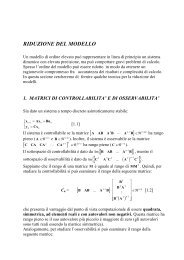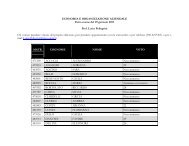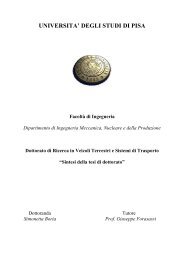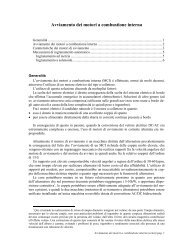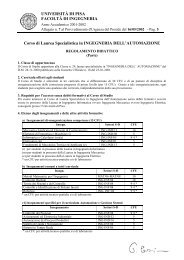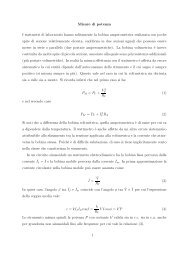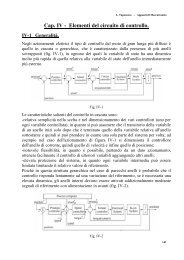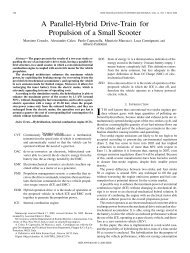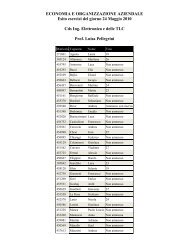Activity Report, year 2009 Research Activity Publications Workshops ...
Activity Report, year 2009 Research Activity Publications Workshops ...
Activity Report, year 2009 Research Activity Publications Workshops ...
You also want an ePaper? Increase the reach of your titles
YUMPU automatically turns print PDFs into web optimized ePapers that Google loves.
Engineering PhD School “Leonardo da Vinci”<br />
PhD Course: Land Vehicles and Transport System<br />
PhD Tutor: Prof. Luigi Martorano<br />
PhD Student: Alessio Simi<br />
<strong>Research</strong> <strong>Activity</strong><br />
<strong>Activity</strong> <strong>Report</strong>, <strong>year</strong> <strong>2009</strong><br />
1. Development of a procedure to evaluate and improve the cooling system effectiveness<br />
of an new engine during the first phase of design (project carried out in collaboration<br />
with Piaggio & C.).<br />
2. Study of a direct injection system for hydrogen fueled engines (H 2 Project founded<br />
by Tuscany district).<br />
3. Cooperation in the Formula SAE team of the University of Pisa for the engine<br />
project.<br />
4. Contributions in activities correlated to biomasses, production and recovery of energy.<br />
<strong>Publications</strong><br />
• M. Antonelli, L. Martorano, A. Simi, “Iniezione diretta di idrogeno in motori a<br />
combustione interna” (Hydrogen direct injection in internal combustion engine”),<br />
New Energy Frontiers, Gaeta 17-19 June <strong>2009</strong><br />
• M. Antonelli, L. Martorano, A. Simi, R. Lensi, C. Morlino, “An energetical and<br />
economical comparison between first and second generation biodiesel production in<br />
the Tuscan district”, 17 th European Biomass Conference, Hamburg 29 June - 3 July<br />
<strong>2009</strong><br />
• M. Antonelli, L. Martorano, A. Simi, S. Di Palma, C. Carapellucci, “A numerical<br />
procedure for the evaluation of the engine Head-Cylinder group cooling effectiveness”,<br />
ASME Summer Heat Transfer Conference, San Francisco 19-23 July <strong>2009</strong><br />
• M. Antonelli, L. Martorano, A. Simi, R. Lensi, “Lumped parameters modeling of an<br />
incinerator with heat recovery for energy production”, ASME Summer Heat Transfer<br />
Conference, San Francisco 19-23 July <strong>2009</strong><br />
<strong>Workshops</strong>, Seminars and Conference<br />
• 17 th European Biomass Conference, Hamburg<br />
• ASME Summer Heat Transfer Conference, San Francisco<br />
• LMS AMESim, Combustione, Trasmissioni e Dinamica Veicolo: tecnologie innovative<br />
per la simulazione numerica e la progettazione, Politecnico di Torino<br />
1
• 11 th International Conference ATA, Architectures for eco-vehicles weight reduction<br />
alternative fuels and propulsions, Università di Firenze<br />
• LMS AMESim, Nuove tecnologie per la progettazione integrata di sistemi meccanici<br />
complessi, Magneti Marelli Powertrain, Bologna<br />
• Workshop ATA, Il motore alternativo alimentato ad idrogeno, Università di Pisa<br />
Education<br />
• English course - level B1+ at CLI (Centro Linguistico Interdipartimentale)<br />
Teaching activities<br />
• Teaching support for the course “Macchine Fluido” of the B.Sc. in Mechanical<br />
Engineering<br />
• Teaching support for the course “Progetto di Macchine” of the M.Sc. in Land Vehicles<br />
Engineering<br />
• Teaching support for the course “Energetica Applicata e Progetto di Macchine Termiche”<br />
of the M.Sc. in Energetical Engineering<br />
1 Cooling Systems<br />
The use of numerical techniques is widely accepted by manufactures in order to increase<br />
engine durability and performances and reduce emissions. The effective thermal load<br />
prediction is always considered a nodal point to correctly assess the coolant mass flow rate<br />
and jackets arrangement.<br />
Engine manufacturers efforts are continuously addressed to improve durability and performances,<br />
while decreasing emissions and costs.<br />
As regard of performances, efficiency and emission, a major role is played by heat transfer<br />
phenomena, that significantly affect the amount of heat transferred to the combustion<br />
chamber walls and hence the work per cycle transferred to the piston. Thus specific power<br />
and efficiency are affected by the magnitude of engine heat transfer.<br />
The main objective of this research was the development of a procedure for the evaluation<br />
of the heat transfer as a function of engine geometry, indicated cycle and coolant mass<br />
flow by means of a steady-state CFD 3D simulation code. The object of the study was a<br />
small single cylinder, four stroke, high power density gasoline Piaggio engine.<br />
More in detail, the average heat transfer coefficients and gases temperatures (both incylinder<br />
and intake/exhaust manifolds) were obtained by properly manipulating the results<br />
of a one-dimensional engine validated model; these value were used as boundary conditions<br />
for the steady-state conjugate simulation.<br />
This procedure is considered very interesting for engine development, since it allows to<br />
verify the effectiveness of the cooling jackets once the thermal cycle of the engine and the<br />
jackets design were defined. It also allows to evaluate the influence of engine fluidynamic<br />
tuning (and hence performances) on the thermal behavior of the engine and then to assess<br />
its degree of reliability.<br />
2
A one-dimensional model was used in order to calculate in-cylinder gas temperature and<br />
convective heat transfer coefficient, to be used as boundary conditions. This model was<br />
created through the Ricardo Wave commercial 1D code, which is widely used by Piaggio &<br />
C. to develop new engines. The one-dimensional model was validated through a comparison<br />
between numerical and experimental data; these last were collected by Piaggio & C. by<br />
means of engine tests in the form of intake and exhaust manifolds pressure, in-cylinder<br />
pressure, lambda value, fuel and air mass flow rate, intake and exhaust gas temperature,<br />
coolant inlet and outlet temperature and engine torque and power. These data were<br />
evaluated at some different rpms, from 3500 to 9000 rpm. The comparisons carried out<br />
between numerical and experimental results led to validate the 1D model response both<br />
from a qualitative and a quantitative point of view.<br />
The instantaneous data obtained by a validated one-dimensional model were transformed<br />
in steady-state value by a heat transfer numerical methodology. The heat transfer between<br />
walls and coolant can be reduced to a simple steady state problem because the engine<br />
speed is high enough to let the temperature fluctuations due to combustion only penetrate<br />
about only one or two millimeters into the cylinder walls. Owing to this, the assumption of<br />
a quasi steady heat transfer process is sufficiently accurate for most calculation purposes.<br />
Model boundary conditions were mostly taken from the results obtained through the one<br />
dimensional model while other boundary conditions were taken from literature or internal<br />
Piaggio & C. data. Constant gas temperature and convective heat transfer coefficients<br />
were applied to all surfaces that are in contact with combustion gas, during the whole<br />
engine cycle. These surfaces are liner, head internal surface (combustion chamber), spark<br />
plug head and valves head. In this simulation model, some boundary conditions were<br />
directly set by means of known data and other by the results of a heat transfer model.<br />
More in particular, boundary conditions were applied in a different way to head and liner:<br />
the head is permanently subject to combustion gases, during the whole engine cycle, the<br />
second, the liner surface is alternatively in contact with surface piston and with combustion<br />
gases where non-uniform conditions were applied.<br />
The results of the simulation were compared with experiments from a quantitative point<br />
of view as regard of temperature rise inside the engine coolant jackets. The simulated<br />
overall thermal flow through the cooling system appears to be coherent both with the<br />
experimental measurements and with typical data that can be found in literature. The<br />
temperature field of the solid and fluid were analyzed from a qualitative point of view,<br />
since experimental data are not still available. However temperatures values observed are<br />
consistent with typical average literature data.<br />
2 H 2 Project<br />
This activity was a part of a project funded by the Tuscany District and carried out in<br />
cooperation between the Dipartimento di Energetica, the Dipartimento di Sistemi Elettrici<br />
e Automazione, the Dipartimento di Ingegneria dell’Informazione and the Dipartimento di<br />
Ingegneria Meccanica, Nucleare e della Produzione of the University of Pisa.<br />
The main objective was the study of a hydrogen injection directly in the cylinder of the<br />
engine using a commercial injector. This activity was used to evaluate the ability and<br />
applicability of the direct injection, in terms of maximum displacement and speed velocity.<br />
The wide flammability limits, high flame speed and low quenching gap of hydrogen permits<br />
very lean operation and in turn, high thermal efficiency with near zero emissions; the only<br />
nontrivial pollutant from hydrogen engines is nitrogen oxides NO x .<br />
3
In this research, two engine model was analyzed; the first one was the Lombardini LGA<br />
340, a small single cylinder, four stroke, spark-ignition engine with displacement of 338cm 3<br />
and maximum power of 7.5kW at 3600rpm. The second one was the Lombardini LG<br />
500, a small single cylinder, four stroke, compression-ignition engine with displacement of<br />
505cm 3 and maximum power of 8.2kW at 3600rpm. The application of these engine is<br />
predicted for a “range extender” in hybrid-serie electrical vehicles.<br />
Parametric one-dimensional models were builded for both engine through Ricardo Wave and<br />
LMS AMESim commercial code; the engine models were validated through a comparison<br />
between numerical and experimental data, provided by Lombardini and Department test.<br />
The one-dimensional models were used in order to calculate the air flow rate and the<br />
necessary hydrogen for each cycle; a specific injector was chosen to satisfy the hydrogen<br />
injection characteristic. The injector is manufactured by Orbital and allows an “air-assisted”<br />
injection, where hydrogen gas and water are both introduced in the cylinder at the same<br />
time.<br />
Thanks to parametric one-dimensional engine models, some configuration were analyzed,<br />
varying parameters as equivalence ratio, injection pressure and rpm.<br />
3 Formula SAE<br />
For the second <strong>year</strong>, the E-Team Squadra Corse of University of Pisa participates at<br />
Formula SAE challenger, where a students’ team design and build a race car according to<br />
the Formula SAE rules.<br />
In this activity research, the study was focused about the engine Aprilia 550 RX and its<br />
additional features. The goal of this activity was to design and to build a whole propulsion<br />
system, in order to increase performance and to reduce consumption compared with the<br />
2008 race car, the ET1. Improvement were applied to intake system, exhaust system,<br />
cooling system, clutch and engine control unit. These modifications were installed on the<br />
ET2ev, the <strong>2009</strong> race car.<br />
The one-dimensional model, created for the ET1 engine, was refined thanks to experimental<br />
data obtained by dyno test, flow bench and road test.<br />
Parametric one-dimensionale model and CFD 3D study were used to design the intake and<br />
exhaust system, in order to reduce pressure losses and to increase the discharge coefficient.<br />
A bibliographic research about the ethanol production and its own characteristics regarding<br />
its employment as a fuel was introduced for the Aprilia engine.<br />
Some one-dimensional engine parameters as fuel kind and air-fuel ratio were modified, in<br />
order to obtain the engine distinctive curves in case of fuel supply by E85.<br />
4 Correlated <strong>Activity</strong><br />
Two correlated activity were studied during the <strong>2009</strong> activity research. The first one was<br />
an energetical and economical comparison between first and second generation biodiesel<br />
production in the Tuscan district and the second one was a parametric study of an<br />
incinerator with heat recovery for energy production.<br />
4



